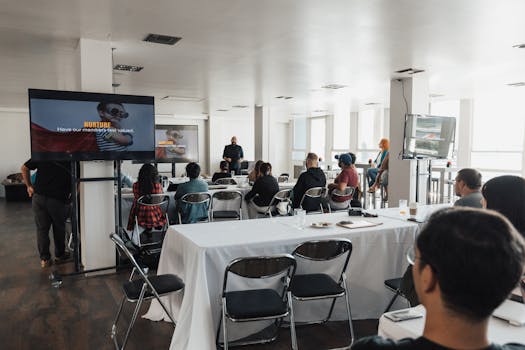The landscape of technology communities is evolving rapidly, driven by innovations in digital communication and collaboration tools. These communities are crucial for aspiring tech professionals, seasoned experts, and hobbyists alike. As we look toward the future, understanding the transformations in tech communities will be essential.
Tech communities are not merely platforms for discussion; they are vibrant ecosystems that foster innovation and growth. With the rise of remote work and more accessible online resources, the scope and nature of these communities are changing. This evolution presents exciting possibilities for engagement and collaboration.
In this article, we will explore the future of tech communities, highlighting key trends and emerging practices shaping these spaces. From the importance of inclusivity to the role of artificial intelligence, the landscape is rich with opportunity.
The Rise of Virtual Collaboration
Virtual collaboration is redefining how tech communities interact and share knowledge. By leveraging technology, participants can engage from anywhere in the world. Consequently, geographical limitations are becoming obsolete.
Tools like video conferencing, project management software, and digital forums facilitate real-time communication. These platforms ensure members can collaborate seamlessly on projects and initiatives. For example, GitHub and Slack are widely used in many communities.
Moreover, virtual collaboration fosters diversity in participation. Individuals from various backgrounds can join discussions and contribute unique perspectives. This diversity enriches the community and drives innovation.
As communities adopt more collaborative technologies, the need for effective moderation becomes critical. Maintaining a respectful and constructive environment is essential for productive discussions. Moderation tools and best practices will evolve alongside these technologies.
Ultimately, as virtual collaboration strengthens, tech communities will likely see an increase in global participation. This shift will broaden the knowledge base and enhance creative problem-solving in the industry.
Inclusivity as a Core Value
Inclusivity is becoming a fundamental pillar for tech communities. The awareness of systemic barriers in technology has prompted many to prioritize diverse representation. Cultivating an inclusive environment fosters innovation and creativity.
Many communities now explicitly encourage participation from underrepresented groups. Efforts include mentorship programs, scholarships, and tailored workshops to support diverse voices. Such initiatives play a crucial role in leveling the playing field.
Workshops and events that spotlight diverse perspectives help dismantle stereotypes. They create spaces for open dialogue about challenges and successes faced by marginalized groups in tech. Sharing experiences encourages empathy among community members.
Furthermore, promoting inclusivity leads to better decision-making within tech communities. Diverse teams are known to produce more innovative solutions by merging different viewpoints. This quality enhances problem-solving capabilities in complex projects.
Adopting inclusivity as a core value in tech communities will shape their future positively. Embracing diverse perspectives sets the stage for continuous growth and learning within the tech landscape.
The Role of Artificial Intelligence
Artificial intelligence is becoming integral to tech community development. AI tools facilitate various tasks, from content moderation to personalized learning experiences. This automation allows communities to focus on engagement and collaboration.
For instance, AI can analyze user interactions to recommend content that suits individual members. Personalized experiences promote deeper engagement, keeping participants active and connected. This customization enhances the overall community experience.
Moreover, AI-driven analytics can help community leaders assess engagement trends. They can use this data to tailor initiatives that meet the evolving needs of their members. As a result, communities become more user-centered and dynamic.
On the other hand, ethical considerations around AI tools must also be addressed. Ensuring transparency and preventing bias in algorithms is critical for maintaining trust within communities. Communities must approach AI implementation cautiously and responsibly.
As AI continues to evolve, its potential for enhancing tech communities will grow. By embracing these technologies wisely, communities can unlock new levels of interaction and innovation.
Building Resilient Communities
The future of tech communities will depend on their ability to adapt and remain resilient in the face of challenges. Recent events have shown the importance of having robust structures in place. Preparedness is key to overcoming uncertainties.
Building resilient communities involves fostering strong relationships among members. Trust and collaboration will help communities weather any storm. Members should be encouraged to support one another during challenging times.
Moreover, having diverse communication channels can provide alternatives when traditional methods falter. If a platform goes down or faces technical issues, communities should have backups ready. This redundancy ensures ongoing engagement.
Leadership within these communities should prioritize conflict resolution strategies. Proactive measures can help mitigate disputes before they escalate. Encouraging open communication fosters a safe space for discussing differences of opinion.
Ultimately, resilience is not just about having a crisis plan. It’s also about cultivating a culture that embraces change and innovation. Tech communities must remain adaptable to thrive continuously.
Cross-Disciplinary Collaboration
Cross-disciplinary collaboration is expected to gain prominence within tech communities. By mingling professionals from various fields, communities can generate fresh ideas and solutions. This interplay drives innovation across sectors.
Collaborating with experts from diverse backgrounds enriches discussions. It opens avenues for combining tech with arts, sciences, business, and social issues. Such collaboration fosters a holistic approach to problem-solving.
Many tech communities are already seeing successful cross-disciplinary initiatives. Hackathons, workshops, and collaborative projects now involve participants from varying fields. These interactions spark creativity and promote out-of-the-box thinking.
Universities and organizations can facilitate such collaborations by encouraging interdisciplinary courses and programs. By creating them, they prepare future leaders to think broadly and work across traditional boundaries.
As tech communities embrace cross-disciplinary collaboration, they can address complex societal challenges more effectively. The resulting synergy can lead to groundbreaking advancements in technology and beyond.
Community-Driven Learning
Community-driven learning is reshaping education within tech communities. As members share knowledge and skills, learning becomes collective rather than solely independent. This approach enhances engagement and fosters deeper connections.
Tech communities are incorporating mentorship programs where experienced members guide newcomers. This mentorship not only builds skills but also strengthens community ties. Participants gain invaluable insights from shared experiences.
Online courses and webinars led by community members are becoming more popular. These resources provide a platform for sharing expertise while promoting interactive learning. Additionally, online recordings can cater to different learning paces and preferences.
Moreover, community events such as hackathons and coding challenges encourage hands-on learning. These activities provide practical experience and foster teamwork among members, enhancing collaborative skills.
The shift toward community-driven learning reflects the evolving nature of education. As tech communities embrace this concept, the opportunities for growth and development will only expand.
Conclusion
The future of tech communities is filled with promise and potential. By embracing virtual collaboration, inclusivity, and innovative technologies like AI, these communities can flourish. Additionally, prioritizing resilience and cross-disciplinary collaboration will strengthen their foundations.
As members engage in community-driven learning experiences, they enrich not only their skills but also the collective knowledge pool. This transformation shapes the future landscape of technology and innovation.
By continuously evolving and adapting to emerging trends, tech communities can illuminate the path forward for the industry. Ultimately, the strength of these communities lies in their ability to unite diverse voices toward a common goal.


